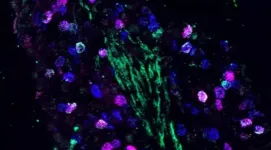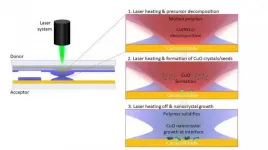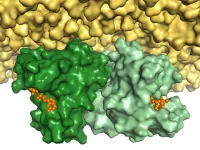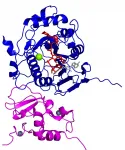(Press-News.org) Autistic people's ability to accurately identify facial expressions is affected by the speed at which the expression is produced and its intensity, according to new research at the University of Birmingham.
In particular, autistic people tend to be less able to accurately identify anger from facial expressions produced at a normal 'real world' speed. The researchers also found that for people with a related disorder, alexithymia, all expressions appeared more intensely emotional.
The question of how people with autism recognise and relate to emotional expression has been debated by scientists for more than three decades and it's only in the past 10 years that the relationship between autism and alexithymia has been explored.
This new study, published in the Journal of Autism and Developmental Disorders, uses new techniques to explore the different impacts of autism and alexithymia on a person's ability to accurately gauge the emotions suggested by different facial expressions.
Connor Keating, a PhD researcher in the University of Birmingham's School of Psychology and Centre for Human Brain Health, is lead author of the study. He says: "We identified that autistic people had a specific difficulty recognising anger which we are starting to think may relate to differences in the way autistic and non-autistic people produce these expressions. If this is true, it may not be accurate to talk about autistic people as having an 'impairment' or 'deficit' in recognising emotion- it's more that autistic and non-autistic faces may be speaking a different language when it comes to conveying emotion".
In the study, 31 autistic and 29 non-autistic participants were asked to identify emotions from a series of moving images made up of dots representing the key dynamic points of a facial expression - a little bit like the dots used to translate human movement into CGI animation. The images were displayed at a range of emotional intensities by varying the amount of movement in each expression, and at a variety of speeds.
The team found that both autistic and non-autistic participants had similar recognition capabilities at different speeds and intensities across all the emotions shown, except for one particular aspect - the autistic group were less able to identify angry expressions produced at normal speed and intensity. These represented the sorts of angry expressions that might be encountered in everyday life.
"When we looked at how well participants could recognise angry expressions, we found that it was definitely autistic traits that contribute, but not alexithymic traits," explained Connor. "That suggests recognising anger is a difficulty that's specific to autism."
A key trait that the team found was specific to participants with alexithymia was a tendency to perceive the expressions to be intensely emotional. Interestingly though, people with alexithymia were more likely to give higher correct and incorrect emotion ratings to the expressions. To give an example, those with alexithymia would rate a happy expression as more intensely happy and more intensely angry and sad than someone without alexithymia.
Connor explains: "One idea is that people with alexithymia are less able to gauge the intensity of emotional expressions and are more likely to get confused about which emotion is being presented."
He adds: "Everyone will know or meet somebody with autism at some point in their lives.By better understanding how people with autism perceive and understand the world we can start to develop training and other interventions for both autistic and non-autistic people to overcome some of the barriers to interacting successfully."
INFORMATION:
This project was supported by the Medical Research Council (MRC, United Kingdom) MR/R015813/1 and the European Union's Horizon 2020 Research and Innovation Programme under ERC-2017-STG Grant Agreement No. 757583.
Notes to editor:
The University of Birmingham is ranked amongst the world's top 100 institutions. Its work brings people from across the world to Birmingham, including researchers, teachers and more than 6,500 international students from over 150 countries.
Keating et al (2021). 'Differences between autistic and non-autistic adults in the recognition of anger from facial motion remain after controlling for alexithymia'. Journal of Autism and Developmental Disorders.
Previous relevant research: Keating, C. T., & Cook, J. L. (2020). Facial Expression Production and Recognition in Autism Spectrum Disorders: A Shifting Landscape. Child and Adolescent Psychiatric Clinics of North America, 29(3), 557-571.
The gut and the brain communicate with each other in order to adapt satiety and blood sugar levels during food consumption. The vagus nerve is an important communicator between these two organs. Researchers from the Max Planck Institute for Metabolism Research in Cologne, the Cluster of Excellence for Ageing Research CECAD at the University of Cologne and the University Hospital Cologne now took a closer look at the functions of the different nerve cells in the control centre of the vagus nerve, and discovered something very surprising: although the nerve cells are located in the same control center, they innervate different regions of the gut and also differentially control satiety and blood sugar levels. This discovery could play an important role in the development of future ...
In the journal Nature Communications, an interdisciplinary team from the Max Planck Institute of Colloids and Interfaces presents for the first time a laser-driven technology that enables them to create nanoparticles such as copper, cobalt and nickel oxides. At the usual printing speed, photoelectrodes are produced in this way, for example, for a wide range of applications such as the generation of green hydrogen.
Previous methods produce such nanomaterials only with high energy input in classical reaction vessels and in many hours. With the laser-driven technology developed at the institute, the scientists can deposit small amounts of material on a surface and simultaneously perform chemical synthesis in a very short time using high temperatures from the laser. 'When I discovered ...
A facial expression or the sound of a voice can say a lot about a person's emotional state; and how much they reveal depends on the intensity of the feeling. But is it really true that the stronger an emotion, the more intelligible it is? An international research team comprised of scientists from the Max Planck Institute for Empirical Aesthetics, New York University, and the Max Planck NYU Center for Language, Music, and Emotion (CLaME) has now discovered a paradoxical relationship between the intensity of emotional expressions and how they are perceived.
Emotions ...
Researchers from Bochum and Osnabrück have gained new insights into the structure of the Ras protein, which acts as a molecular switch for cell growth and is involved in the development of cancer. With the help of fluorescence markings, they have demonstrated that the protein is deposited in a pair at the cell membrane, and with the very structure that they predicted in theory back in 2012. The team from the Bochum Center for Protein Diagnostics (PRODI) hopes that these findings will open up a new approach for the development of cancer medications. The researchers from Ruhr-Universität Bochum (RUB) and Osnabrück University ...
Prenuptial agreements, or "prenups," can be difficult to talk about. But a recent study offers insights into how people can discuss this often taboo subject. One approach? Use metaphors.
"Many people view prenups as being negative, and argue that they indicate a lack of faith in the marriage from the outset," says Lynsey Romo, corresponding author of the study and an associate professor of communication at North Carolina State University. "By the same token, we know from other research that open communication about financial issues contributes to successful relationships.
"And yet there is virtually no academic research on prenups. So how do people talk about prenups? How do they make sense of them? That's what we wanted ...
SAN ANTONIO (June 2, 2021) -- Scientists from The University of Texas Health Science Center at San Antonio have discovered a mechanism by which SARS-CoV-2 exploits changes in metal ion concentrations to disguise itself in the body. Varying concentrations of metal ions -- positively charged atoms such as magnesium, manganese and calcium -- are observed in hospitalized COVID-19 patients.
"This is a newly described metal-dependent mechanism by which these ions help the virus to evade immune surveillance," said END ...
RUDN University chemists proposed a new way to synthesize catalysts for the conversion of ethyl alcohol. The obtained materials are promising catalysts for the selective conversion of ethanol, which is an important stage in the development of an alternative technology for obtaining valuable chemical synthesis products based on plant raw materials. The results of the study are published in Catalysis Today.
Ethanol fuel is ethyl alcohol, it is produced from plant material by fermentation of industrial or agricultural waste biomass. It is used as a more environmentally ...
In collaborative international effort, laser physicists at LMU have built the first hybrid plasma accelerator.
Particle accelerators have made crucial contributions to some of the most spectacular scientific discoveries of modern times, and greatly augmented our knowledge of the structure of matter. Now a team of laser physicists led by Prof. Stefan Karsch at the Ludwig-Maximilian University (LMU) in Munich and the Max Planck Institute for Quantum Optics, in cooperation with scientists based at the Helmholtz Centre in Dresden-Rossendorf (HZDR), the Laboratoire d'Optique Appliquée in Paris (LOA), Strathclyde University in Glasgow and the DESY Electron Synchrotron in Hamburg, have now achieved a significant ...
Amsterdam, June 2, 2021 - On the eve of the 50th anniversary of the 1972 Stockholm conference that created the United Nations Environmental Programme, it is clear that the global environmental situation has only deteriorated. In "Our Earth Matters: Pathways to a Better Common Environmental Future," an extended special issue of Environmental Policy and Law (EPL), leading scholars from more than five continents call for an honest introspection of what has been attained over the last 50 years relating to regulatory processes and laws and explore future trajectories with new ideas and frameworks for environmental governance in the 21st century.
"Our objective is to fire the imaginations of scholars and decision-makers to re-examine current approaches and to explore the future, ...
Smoking in early puberty in boys may have negative consequences for their future generations of offspring, a study from the University of Bergen (UiB) shows.
By continued analysis of data gathered in the large international RHINESSA, RHINE and ECRHS studies, researchers have found that the health of future generations depends on actions and decisions made by young people today. This is particularly relevant for boys in early puberty and mothers/grandmothers both pre-pregnancy and during pregnancy, the study shows.
The paper "Prenatal and prepubertal exposures to tobacco smoke in ...







